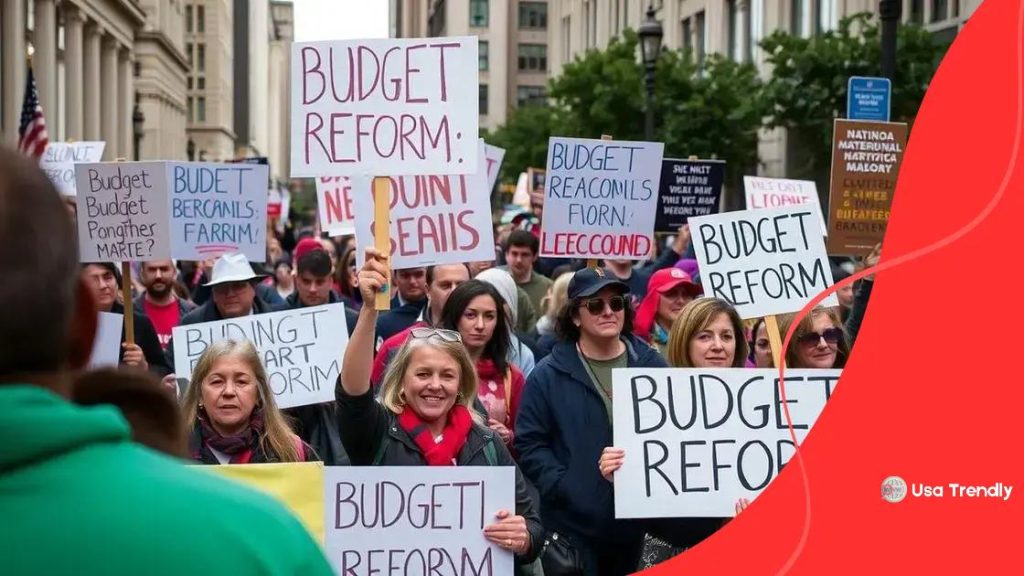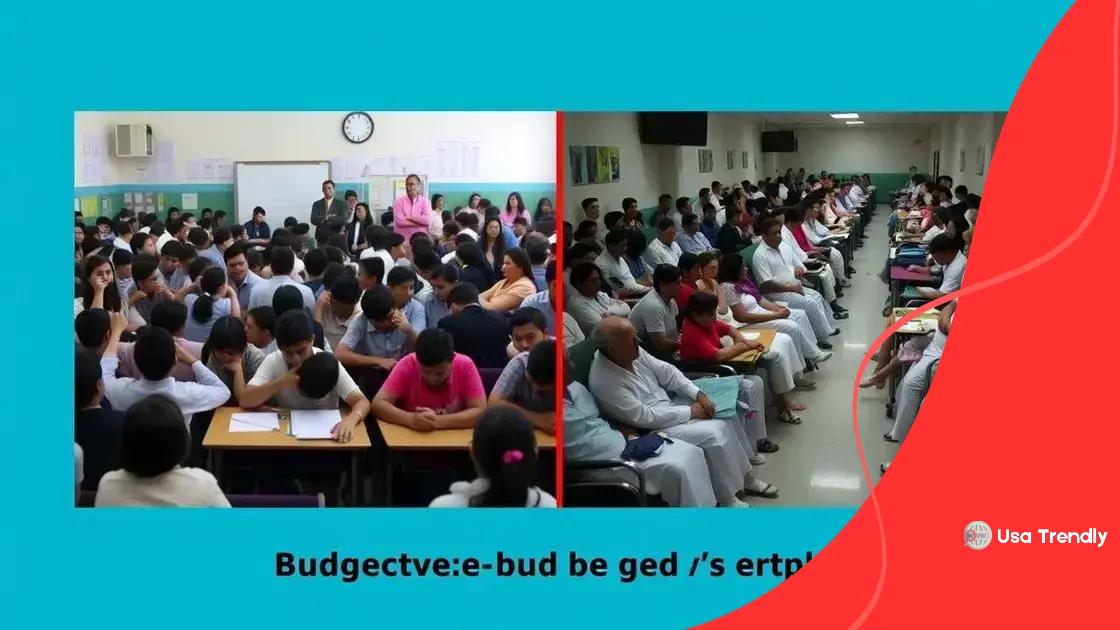Public sector protests intensify over budget cuts

Public sector protests are intensifying over budget cuts, with communities demanding better funding and resources for essential services like education, healthcare, and public safety.
Public sector protests intensify over budget cuts are sweeping across various communities, highlighting the urgent need for adequate funding and resources. What’s behind these growing demonstrations, and how does it impact the daily lives of citizens? Let’s delve deeper.
The rise of public sector protests
The rise of public sector protests reflects growing discontent among employees and citizens alike. As budget cuts continue to affect essential services, many are stepping forward to demand change. The impact of these cuts is felt in schools, hospitals, and local governments, leading to an outcry for better funding.
Factors Contributing to Protests
Several reasons fuel the flames of dissent in the public sector. First, economic pressures have made it challenging for governments to maintain previous funding levels. This has led to significant cuts in public services.
- Declining tax revenues
- Rising costs of living
- Increased demands for services
Moreover, workers’ rights are more crucial than ever. Employees demand attention to their needs, and reduced budgets often mean layoffs or lost benefits. This creates an atmosphere of uncertainty and fear.
Community Involvement
Community engagement is vital in supporting public sector protests. When citizens join forces with public workers, they amplify their calls for change. Neighborhood groups organize rallies and events, aiming to raise awareness regarding the negative consequences of budget cuts.
In addition, many activists highlight the importance of maintaining quality services. From education to healthcare, everyone deserves access to well-funded public services. By standing together, communities can send a clear message to their leaders.
The rise of public sector protests signifies a critical moment in advocacy for funding and services. As pressures continue to mount, expect to see more organized efforts to achieve necessary changes. With the public’s support, these movements can create positive impacts in their communities.
Economic factors driving budget cuts
Economic factors driving budget cuts are becoming increasingly evident in many public sectors. As governments face financial constraints, tough decisions often lead to reductions in funding for crucial services. This trend affects schools, healthcare, and public safety, impacting the daily lives of citizens.
Declining Revenue
One primary factor is the steep decline in tax revenues. When the economy falters, less money flows into government coffers, creating a budget shortfall. Many states and municipalities find themselves unable to maintain existing programs or services.
- Loss of jobs leading to reduced income tax
- Decrease in sales tax revenues
- Reduced business profits affecting corporate tax income
In addition, rising costs continue to put pressure on public budgets. Expenses for items like salaries, benefits, and necessary supplies rise each year, making it harder for governments to allocate funds effectively.
Increased Demand for Services
As the population grows, there is a heightened demand for public services, leading to more strain on budgets. This paradox pushes governments into a corner, where they must either cut existing services or find new revenue sources. It’s not just about balancing the books; it’s about ensuring that communities are served effectively.
Moreover, inflation plays a significant role in exacerbating the situation. As costs increase, funds do not stretch as far. Public sectors often struggle to meet the increasing demands without proper financing.
These economic pressures lead to challenging discussions among policymakers about where to allocate scarce resources. Many fear that failing to invest adequately in public services will create long-term issues in education, health, and safety. Ultimately, these trends highlight the connection between the economy and funding needs in the public sector, as communities strive for support.
How budget cuts affect public services

How budget cuts affect public services is a pressing concern for many communities. As funding decreases, essential services that people rely on become limited, causing significant challenges. The consequences can be seen in various sectors, including education, healthcare, and public safety.
Impact on Education
In schools, budget cuts can lead to fewer resources for teachers and students. Essential programs may be reduced or eliminated, resulting in larger class sizes and less individual attention for students. Some possible effects are:
- Decreased availability of extracurricular activities
- Lack of updated materials or technology
- Reduced staff and support services
This ultimately affects the quality of education and student outcomes, leading to long-term consequences for future generations.
Challenges in Healthcare
In the healthcare sector, budget cuts often result in fewer services offered. Hospitals and clinics may struggle to maintain staffing levels, which can lead to longer wait times and diminished patient care. The implications include:
- Closure of essential community health programs
- Increased pressure on emergency services
- Limited access to preventative care
These changes can significantly impact public health, making communities more vulnerable during crises.
Public safety services are also adversely affected. With decreased funding, police departments and fire services often face cuts that can degrade response times and lower staffing levels. This can make communities feel less secure and lead to increased crime rates. The struggle to balance budgets can create an environment where safety becomes compromised.
Overall, budget cuts can create a ripple effect in communities. As funding declines, public services become strained, leading to significant drawbacks that affect the lives of everyday citizens. Ensuring adequate funding is crucial for the stability and well-being of all community members.
Community responses to budget reductions
Community responses to budget reductions have become increasingly vital as public services face cuts. Citizens are recognizing the importance of activism to ensure their needs are met. Many communities are uniting to advocate for better funding and support for essential services.
Grassroots Movements
One of the most effective ways communities respond is through grassroots movements. These are often led by local residents who organize protests and campaigns to raise awareness. Some common activities include:
- Hosting town hall meetings to discuss concerns
- Creating petitions to gather support for funding
- Utilizing social media to spread the word and mobilize others
This collective effort helps amplify their voice and demands for fair funding.
Collaboration with Local Organizations
Communities often partner with local organizations and advocacy groups to strengthen their efforts. This collaboration can lead to a more effective platform to push for changes. These organizations typically provide resources, strategies, and expertise to help mobilize community members.
Working together, these groups can tackle specific issues caused by budget cuts, such as access to mental health services, educational resources, and public safety initiatives. Each partnership focuses on the unique needs of the community, allowing for tailored responses that resonate with residents.
Another vital response is engaging local media. Communities are reaching out to news outlets to highlight the challenges they face. By sharing stories and personal experiences, they can generate public support, which adds pressure on decision-makers to reconsider budget allocations.
Overall, community responses to budget reductions illustrate the strength of collective action. Residents realizing their voices can make a difference are crucial in advocating for necessary changes and ensuring that essential services remain intact.
Future implications for public sector funding
The future implications for public sector funding are critical as communities face ongoing budget challenges. Anticipating how these changes will affect essential services can help residents better prepare for what lies ahead. The impact of funding reductions is multifaceted, influencing various sectors and the overall well-being of communities.
Long-Term Consequences
One major concern is the potential decline in service quality. As funding decreases, public services may struggle to maintain the standards that citizens expect. This could lead to:
- Larger class sizes in education
- Longer wait times in healthcare
- Reduced public safety measures
The ramifications of these cuts may not be immediately visible, but they can lead to lasting issues that affect future generations.
Changing Funding Structures
Governments may need to rethink how they allocate funds in the face of budgetary pressures. This could mean a shift towards public-private partnerships, where private entities help fund essential services. While this can alleviate some financial burdens, it may also lead to challenges related to accountability and service quality.
Moreover, there may be increasing competition among communities for limited funds. Cities and towns might find themselves in a race to demonstrate their need for support. This could prompt some areas to revamp their proposals or seek alternative funding sources to stand out.
As these dynamics evolve, communities must remain engaged in the decision-making process. Ongoing advocacy will be essential to ensure that local needs are met. By staying proactive, residents can help shape a future where public sector funding supports robust, healthy, and vibrant communities.
FAQ – Frequently Asked Questions about Public Sector Funding
What are the main reasons for current public sector budget cuts?
Current public sector budget cuts are primarily due to declining revenues, increased demand for services, and rising operational costs.
How can communities respond to budget cuts effectively?
Communities can respond to budget cuts by organizing grassroots movements, collaborating with local organizations, and actively engaging with media to raise awareness.
What are the potential impacts of budget reductions on public services?
Budget reductions can lead to larger class sizes, longer wait times in healthcare, and reduced public safety measures, ultimately affecting service quality.
Why is advocacy important for public sector funding?
Advocacy is crucial because it helps amplify community voices, ensuring that the needs and priorities of residents are addressed in funding decisions.
SEE MORE CONTENT